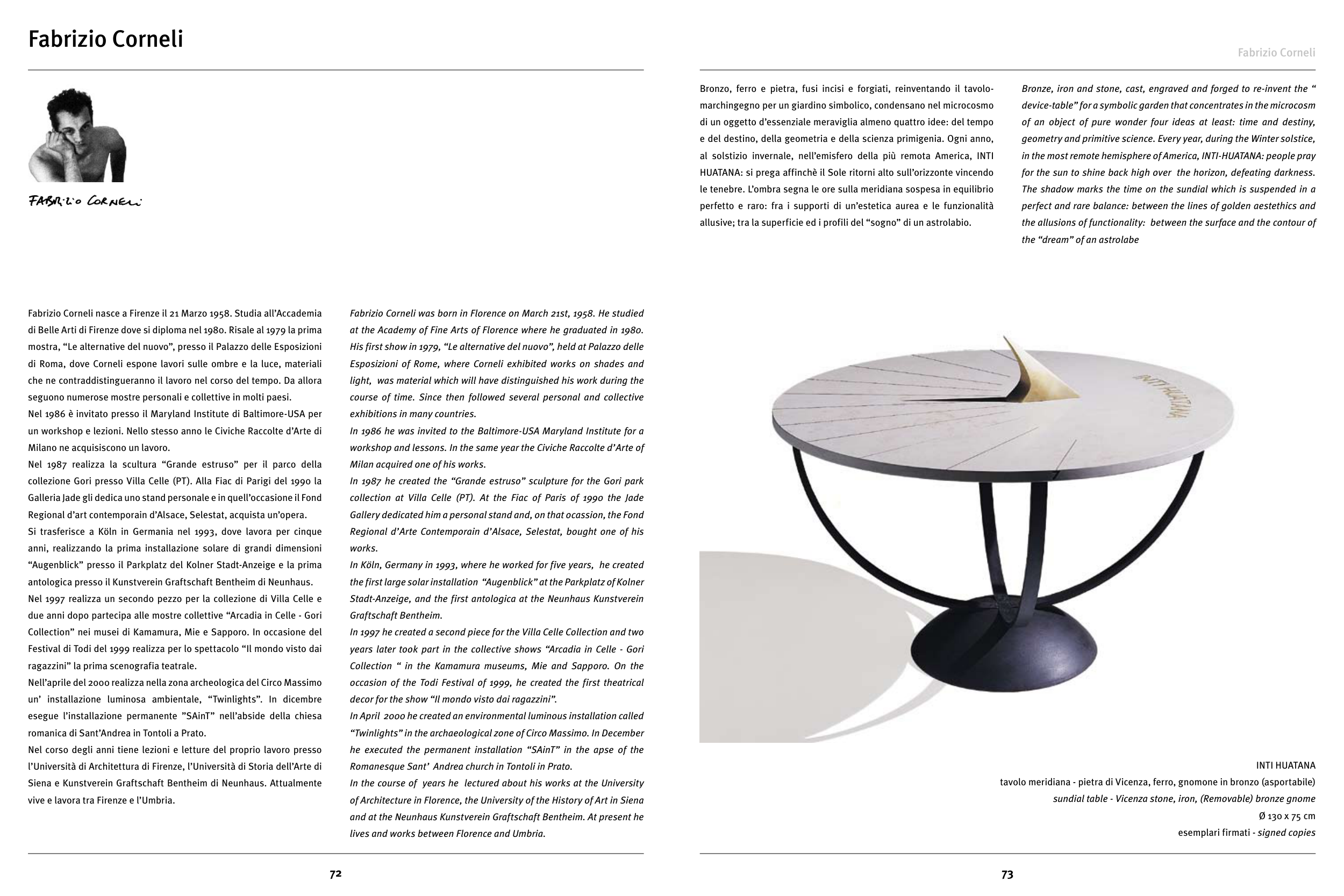Bronze, iron and stone, cast, engraved and forged to re-invent the “
device-table” for a symbolic garden that concentrates in the microcosm
of an object of pure wonder four ideas at least: time and destiny,
geometry and primitive science. Every year, during the Winter solstice,
in the most remote hemisphere of America, INTI-HUATANA: people pray
for the sun to shine back high over the horizon, defeating darkness.
The shadow marks the time on the sundial which is suspended in a
perfect and rare balance: between the lines of golden aestethics and
the allusions of functionality: between the surface and the contour of
the “dream” of an astrolabe
INTI HUATANA
tavolo meridiana - pietra di Vicenza, ferro, gnomone in bronzo (asportabile)
sundial table - Vicenza stone, iron, (Removable) bronze gnome
Ø 130 x 75 cm
esemplari firmati - signed copies
Bronzo, ferro e pietra, fusi incisi e forgiati, reinventando il tavolo-
marchingegno per un giardino simbolico, condensano nel microcosmo
di un oggetto d’essenziale meraviglia almeno quattro idee: del tempo
e del destino, della geometria e della scienza primigenia. Ogni anno,
al solstizio invernale, nell’emisfero della più remota America, INTI
HUATANA: si prega affinchè il Sole ritorni alto sull’orizzonte vincendo
le tenebre. L’ombra segna le ore sulla meridiana sospesa in equilibrio
perfetto e raro: fra i supporti di un’estetica aurea e le funzionalità
allusive; tra la superficie ed i profili del “sogno” di un astrolabio.
Fabrizio Corneli
Fabrizio Corneli nasce a Firenze il 21 Marzo 1958. Studia all’Accademia
di Belle Arti di Firenze dove si diploma nel 1980. Risale al 1979 la prima
mostra, “Le alternative del nuovo”, presso il Palazzo delle Esposizioni
di Roma, dove Corneli espone lavori sulle ombre e la luce, materiali
che ne contraddistingueranno il lavoro nel corso del tempo. Da allora
seguono numerose mostre personali e collettive in molti paesi.
Nel 1986 è invitato presso il Maryland Institute di Baltimore-USA per
un workshop e lezioni. Nello stesso anno le Civiche Raccolte d’Arte di
Milano ne acquisiscono un lavoro.
Nel 1987 realizza la scultura “Grande estruso” per il parco della
collezione Gori presso Villa Celle (PT). Alla Fiac di Parigi del 1990 la
Galleria Jade gli dedica uno stand personale e in quell’occasione il Fond
Regional d’art contemporain d’Alsace, Selestat, acquista un’opera.
Si trasferisce a Köln in Germania nel 1993, dove lavora per cinque
anni, realizzando la prima installazione solare di grandi dimensioni
“Augenblick” presso il Parkplatz del Kolner Stadt-Anzeige e la prima
antologica presso il Kunstverein Graftschaft Bentheim di Neunhaus.
Nel 1997 realizza un secondo pezzo per la collezione di Villa Celle e
due anni dopo partecipa alle mostre collettive “Arcadia in Celle - Gori
Collection” nei musei di Kamamura, Mie e Sapporo. In occasione del
Festival di Todi del 1999 realizza per lo spettacolo “Il mondo visto dai
ragazzini” la prima scenografia teatrale.
Nell’aprile del 2000 realizza nella zona archeologica del Circo Massimo
un’ installazione luminosa ambientale, “Twinlights”. In dicembre
esegue l’installazione permanente ”SAinT” nell’abside della chiesa
romanica di Sant’Andrea in Tontoli a Prato.
Nel corso degli anni tiene lezioni e letture del proprio lavoro presso
l’Università di Architettura di Firenze, l’Università di Storia dell’Arte di
Siena e Kunstverein Graftschaft Bentheim di Neunhaus. Attualmente
vive e lavora tra Firenze e l’Umbria.
Fabrizio Corneli was born in Florence on March 21st, 1958. He studied
at the Academy of Fine Arts of Florence where he graduated in 1980.
His first show in 1979, “Le alternative del nuovo”, held at Palazzo delle
Esposizioni of Rome, where Corneli exhibited works on shades and
light, was material which will have distinguished his work during the
course of time. Since then followed several personal and collective
exhibitions in many countries.
In 1986 he was invited to the Baltimore-USA Maryland Institute for a
workshop and lessons. In the same year the Civiche Raccolte d’Arte of
Milan acquired one of his works.
In 1987 he created the “Grande estruso” sculpture for the Gori park
collection at Villa Celle (PT). At the Fiac of Paris of 1990 the Jade
Gallery dedicated him a personal stand and, on that ocassion, the Fond
Regional d’Arte Contemporain d’Alsace, Selestat, bought one of his
works.
In Köln, Germany in 1993, where he worked for five years, he created
the first large solar installation “Augenblick” at the Parkplatz of Kolner
Stadt-Anzeige, and the first antologica at the Neunhaus Kunstverein
Graftschaft Bentheim.
In 1997 he created a second piece for the Villa Celle Collection and two
years later took part in the collective shows “Arcadia in Celle - Gori
Collection “ in the Kamamura museums, Mie and Sapporo. On the
occasion of the Todi Festival of 1999, he created the first theatrical
decor for the show “Il mondo visto dai ragazzini”.
In April 2000 he created an environmental luminous installation called
“Twinlights” in the archaeological zone of Circo Massimo. In December
he executed the permanent installation “SAinT” in the apse of the
Romanesque Sant’ Andrea church in Tontoli in Prato.
In the course of years he lectured about his works at the University
of Architecture in Florence, the University of the History of Art in Siena
and at the Neunhaus Kunstverein Graftschaft Bentheim. At present he
lives and works between Florence and Umbria.
Fabrizio Corneli
72
73





































































































































